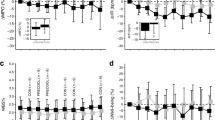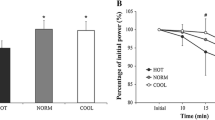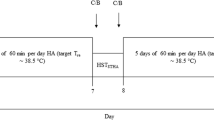Abstract
To determine if the increases in rectal temperature (T REC) during exercise in the heat at a given percent of \( \dot{V}\hbox{O}_{{2\,{\text{peak}}}} \) depend on a subject’s aerobic fitness level. On three occasions, 10 endurance-trained (Tr) and 10 untrained (UTr) subjects (\( \dot{V}\hbox{O}_{2\,{\rm peak}} \): 60 ± 6 vs. 44 ± 3 mL kg−1 min−1, P < 0.05) cycled in a hot-dry environment (36 ± 1°C; 25 ± 2% humidity, airflow 2.5 m s−1) at three workloads (40, 60, and 80% \( \dot{V}\hbox{O}_{2\,{\rm peak}} \)). At the same percent of \( \dot{V}\hbox{O}_{2\,{\rm peak}} \), on average, Tr had 28 ± 5% higher heat production but also higher skin blood flow (29 ± 3%) and sweat rate (20 ± 7%; P = 0.07) and lower skin temperature (0.5°C; P < 0.05). Pre-exercise T REC was lower in the Tr subjects (37.4 ± 0.2 vs. 37.6 ± 0.2; P < 0.05) but similar to the UTr at the end of 40 and 60% \( \dot{V}\hbox{O}_{2\,{\rm peak}} \) trials. Thus, exercise T REC increased more in the Tr group than in the UTr group (0.6 ± 0.1 vs. 0.3 ± 0.1°C at 40% \( \dot{V}\hbox{O}_{2\,{\rm peak}} \) and 1.0 ± 0.1 vs. 0.6 ± 0.3°C at 60% \( \dot{V}\hbox{O}_{2\,{\rm peak}} \); P < 0.05). At 80% \( \dot{V}\hbox{O}_{2\,{\rm peak}} \) not only the increase in T REC (1.7 ± 0.1 vs. 1.3 ± 0.3°C) but also the final T REC was larger in Tr than in UTr subjects (39.15 ± 0.1 vs. 38.85 ± 0.1°C; P < 0.05). During exercise in the heat at the same relative intensity, aerobically trained individuals have a larger rise in T REC than do the untrained ones which renders them more hyperthermic after high-intensity exercise.




Similar content being viewed by others
References
Adams WC, Mack GW, Langhans GL, Nadel ER (1992) Effects of varied air velocity on sweating and evaporative rates during exercise. J Appl Physiol 73:2668–2674
Baldwin J, Snow RJ, Febbraio MA (2000) Effect of training status and relative exercise intensity on physiological responses in men. Med Sci Sports Exerc 32:1648–1654
Brouwer E (1957) On simple formulae for calculating the heat expenditure and the quantities of carbohydrate and fat oxidized in metabolism of men and animals, from gaseous exchange (oxygen and carbonic acid output) and urine-N. Acta Physiol Pharmacol Neerl 6:795–802
Buono MJ, Heaney JH, Canine KM (1998) Acclimation to humid heat lowers resting core temperature. Am J Physiol 274:R1295–R1299
Candas V, Libert JP, Vogt JJ (1979) Influence of air velocity and heat acclimation on human skin wettedness and sweating efficiency. J Appl Physiol 47:1194–1200
Dill DB, Costill D (1974) Calculations of percentage changes in volumes of blood, plasma, and red blood cells with dehydration. J Appl Physiol 9:247–248
Du Bois DBS, Du Bois EF (1916) A formula to estimate the approximate surface area if height and weight be known. Arch Int Med 17:963–971
Fritzsche RG, Coyle EF (2000) Cutaneous blood flow during exercise is higher in endurance-trained humans. J Appl Physiol 88:738–744
Gagnon D, Jay O, Lemire B, Kenny GP (2008) Sex-related differences in evaporative heat loss: the importance of metabolic heat production. Eur J Appl Physiol 104:821–829
Gant N, Williams C, King J, Hodge BJ (2004) Thermoregulatory responses to exercise: relative versus absolute intensity. J Sports Sci 22:1083–1090
Gass GC, McLellan TM, Gass EM (1991) Effects of prolonged exercise at a similar percentage of maximal oxygen consumption in trained and untrained subjects. Eur J Appl Physiol Occup Physiol 63:430–435
Gonzalez-Alonso J, Mora-Rodriguez R, Below PR, Coyle EF (1995) Dehydration reduces cardiac output and increases systemic and cutaneous vascular resistance during exercise. J Appl Physiol 79:1487–1496
Greenleaf JE, Greenleaf J, Card DH, Saltin B (1969) Exercise-temperature regulation in man during acute exposure to simulated altitude. J Appl Physiol 26:290–296
Havenith G, Coenen JML, Kistemaker L, Kenney LW (1998) Relevance of individual characteristics for human heat stress response is dependent on exercise intensity and climate type. Eur J Appl Physiol 77:231–241
Ichinose TK, Inoue Y, Hirata M, Shamsuddin AKM, Kondo N (2008) Enhanced heat loss responses induced by short-term endurance training in exercising women. Exp Physiol 94:90–102
Jackson AS, Pollock ML (1978) Generalized equations for predicting body density of men. Br J Nutr 40:497–504
Kerslake DM (1972) The stress of hot environments. Monogr Physiol Soc 29:1–312
Kräuchi K, Wirz-Justice A (1994) Circadian rhythm of heat production, heart rate, and skin and core temperature under unmasking conditions in men. Am J Physiol 267:R819–R829
Kuwahara T, Yoshimitsu I, Abe M, Sato Y, Kondo N (2005) Effects of menstrual cycle and physical training on heat loss responses during dynamic exercise at moderate intensity in a temperate environment. Am J Physiol Regul Integr Comp Physiol 288:R1347–R1353
Lind AR (1963) A physiological criterion for setting thermal environmental limits for everyday work. J Appl Physiol 18:51–56
Mitchell J, Nadel E, Stolwijk J (1972) Respiratory weight losses during exercise. J Appl Physiol 32:474–476
Nadel ER, Pandolf KB, Roberts MF, Stolwijk JA (1974) Mechanisms of thermal acclimation to exercise and heat. J Appl Physiol 37:515–520
Nielsen B, Hales J, Strange S, Christensen N, Warberg J, Saltin B (1993) Human circulatory and thermoregulatory adaptations with heat acclimation and exercise in a hot, dry environment. J Physiol 460:467–485
Ramanathan N (1964) A new weighting system for mean surface temperature of the human body. J Appl Physiol 19:531–533
Robinson TE, Sue DY, Huszczuk A, Weiler-Ravell D, Hansen JE (1988) Intra-arterial and cuff blood pressure responses during incremental cycle ergometry. Med Sci Sports Exerc 20:142–149
Rowell L, Freund P, Brengelmann G (1982) Cutaneous vascular response to exercise and acute hypoxia. J Appl Physiol 53:920–924
Saltin B, Hermanssen L (1966) Esophageal, rectal and muscle temperature during exercise. J Appl Physiol 21:1757–1762
Sawka MN, Toner MM, Francesconi RP, Pandolf KB (1983) Hypohydration and exercise: effects of heat acclimation, gender, and environment. J Appl Physiol 55:1147–1153
Shvartz E, Magazanik A, Glick Z (1974) Thermal responses during training in a temperate climate. J Appl Physiol 36:572–576
Smolander J, Saalo J, Korhonen O (1991) Effect of work load on cutaneous vascular response to exercise. J Appl Physiol 71:1614–1619
Vincent WJ (1999) Statistics in kinesiology. Human Kinetics, Champaign, pp 171–187
Acknowledgments
The study was partially supported by a grant from the Spanish Ministry of Education DEP2006-56076-C06-02. Juan Del Coso and Nassim Hamouti were supported by a pre-doctoral fellowship from the Castilla-La Mancha government in Spain. Juan F. Ortega was supported by a Latin-American grant from the Gatorade Sports Science Institute. The authors of this study declare that the experiments comply with the current laws of the country in which they were performed. The study was approved by the local Hospital Research Ethics Committee and conducted in accordance with the guidelines of the revised Declaration of Helsinki.
Conflict of interest statement
The authors of this study declare that they have no financial, professional or other personal interest of any nature in any product, service and/or company that could be construed as influencing the position presented in this manuscript.
Author information
Authors and Affiliations
Corresponding author
Additional information
Communicated by George Havenith.
Rights and permissions
About this article
Cite this article
Mora-Rodriguez, R., Coso, J.D., Hamouti, N. et al. Aerobically trained individuals have greater increases in rectal temperature than untrained ones during exercise in the heat at similar relative intensities. Eur J Appl Physiol 109, 973–981 (2010). https://doi.org/10.1007/s00421-010-1436-4
Accepted:
Published:
Issue Date:
DOI: https://doi.org/10.1007/s00421-010-1436-4




